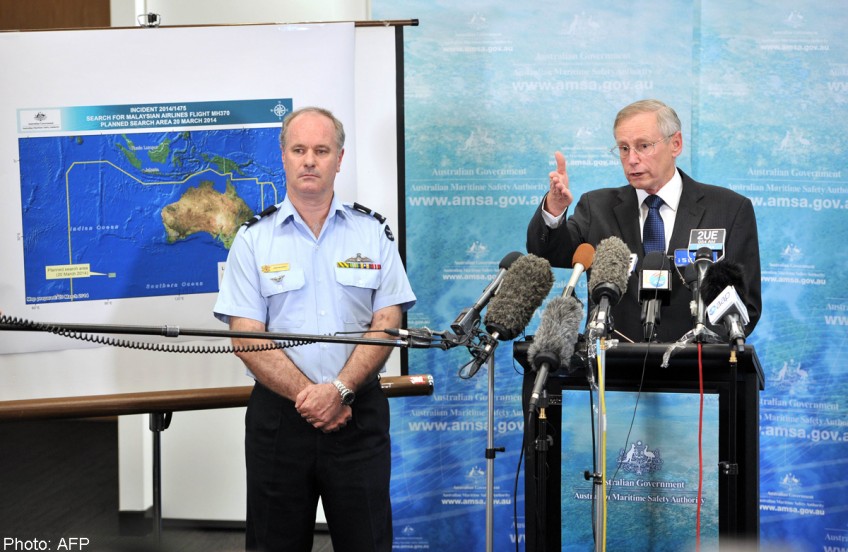Missing MH370: Satellite images 'credible enough to divert search efforts'

PERTH - Australian intelligence officials pored over "grainy" satellite images frame by frame to conclude that they were credible enough to redirect search efforts for the missing Malaysia Airlines plane to an area about 2,500km south-west of Perth.
"The task of analysing imagery is quite difficult. It requires drawing down frames and going through frame by frame," Royal Australian Air Force Air Commodore John McGarry said last Thursday. He said the moment the imagery indicated a possible object and debris field, the information was passed to the Australian Maritime Safety Authority (Amsa).
"It is credible enough to divert the (search) to this area on the basis it provides a promising lead to what might be wreckage from the debris field," Air Commodore McGarry of the Australian Geospatial-Intelligence Organisation told a press briefing in Canberra.
The satellite images showing two objects floating in the southern Indian Ocean - the larger measuring 24m and the other 5m - were taken on Sunday.
In an effort to dampen heightened expectations, senior Amsa official John Young, who was also at the press briefing, stressed that the objects may be difficult to locate and may even not be related to the search for Flight MH370.
"The objects are relatively indistinct on the imagery. I don't profess to be an expert in assessing the imagery, but those who are expert indicate they are credible sightings," he said.
"The indications to me are of objects that are a reasonable size and probably awash with water bobbing up and down under the surface."
Mr Young, general manager of Amsa's Emergency Response Division, said more images were expected "in due course", with commercial satellites redirected to take high-resolution images of the areas of interest.
Australian Defence Minister David Johnston was even more circumspect about the possibility of finding debris. The fact that the satellite photos were taken on Sunday meant the objects would have been subjected to four days of ocean drift in a "most isolated part of the world". This would make them a "logistical nightmare" to locate, he said.
He also said officials did not expect to report anything definite for "two or three days".
It takes four hours for an aircraft flying out from Perth to reach the area where the debris is located. The water there, according to Mr Young, is "several thousand metres deep".
Four long-range surveillance aircraft - two from Australia and one each from the United States and New Zealand - were scouring the area on Thursday. Poor visibility owing to cloud and rain was hampering the search from the air.
Norwegian car carrier Hoegh St Petersburg, which was redirected to the vicinity, arrived on last Thursday afternoon.
Australian naval vessel HMAS Success, capable of retrieving any debris, has been dispatched from Fremantle, but will take a few days to get there. Another merchant ship is also on its way to the area.
The Beijing-bound Boeing 777- 200ER from Kuala Lumpur vanished in the early hours of March8 after veering drastically off course over the South China Sea.
Sketchy radar and satellite data resulted in investigators proposing two vast search corridors, stretching south into the Indian Ocean and north over South and Central Asia.
Many analysts now favour the maritime southern corridor, pointing out the unlikelihood of an airliner passing undetected over nearly a dozen countries.
The international search has been marked by numerous false leads thus far. During searches in the South China Sea, two large oil slicks suspected to be from MH370 were found to be a type of oil used in ships, while a reported lifeboat was found to be a cable reel covered in seaweed.
Debris purported to be an aircraft door was also reported to be floating in the Gulf of Thailand. Chinese satellites also pinpointed debris, which was later not borne out.
Mr Young characterised the latest satellite imagery as the "best lead" Australia had now.
"This is a lead; it is probably the best lead we have right now. But we need to get there, find them, see them, assess them, to know whether it is really meaningful or not," he said.
jmenon@sph.com.sg

Get a copy of The Straits Times or go to straitstimes.com for more stories.
[[nid:94418]]